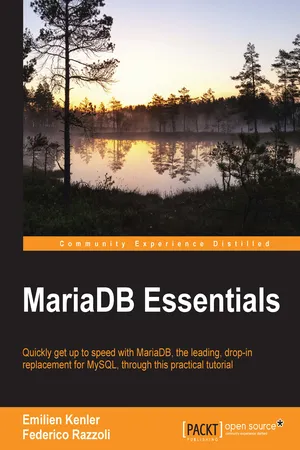![]()
![]()
Table of Contents
MariaDB Essentials
Credits
About the Authors
About the Reviewers
www.PacktPub.com
Support files, eBooks, discount offers, and more
Why subscribe?
Free access for Packt account holders
Preface
What this book covers
What you need for this book
Who this book is for
Conventions
Reader feedback
Customer support
Downloading the example code
Errata
Piracy
Questions
1. Installing MariaDB
Choosing a MariaDB version
Installing MariaDB
Installing on Windows
The noinstall package
The package for Microsoft Installer
Installing on Linux
Using official repositories
The .deb packages
The .rpm packages
Installing MariaDB on Gentoo
Generic Linux binaries
Installing on MacOS
Starting and stopping MariaDB
Getting started with the mysql client
Starting and quitting the client
Running queries
Client commands
Configuring MariaDB
Configuration files
Passing options to mysqld
Setting server variables at runtime
Upgrading MariaDB
Managing plugins
Summary
2. Databases and Tables
Working with databases
Working with tables
Working with columns
Data types
String types
Numeric types
Temporal types
ENUM and SET types
NULL values
Default values
Character sets and collations
Storage engines
Indexing
Using comments
Working with metadata
Creating an installation script
Summary
3. Getting Started with SQL
Working with rows
Inserting rows
Modifying rows
Deleting rows
Understanding transactions
The autocommit mode
The limitations of a transaction in MariaDB
Foreign keys
Creating relationships between tables
Foreign keys explained
Self-referencing tables
Many-to-many relationships
Dealing with duplicates and consistency errors
Reading rows
Specifying the table and column names
Aggregate functions
Filtering rows
Sorting rows
Limiting the number of rows
Grouping results
Joining tables
The cross join operation
The inner join operation
The left join and right join operations
Unions
Subqueries
Scalar subqueries
Row subqueries
Table subqueries
Derived tables
Working with operators
Comparison operators
String operators
The LIKE operator and its variants
Using regular expressions with the REGEXP operator and its variants
Logical operators
The NOT operator
The AND operator
The OR operator
The XOR operator
Arithmetic operators
Operator precedence
Working with times and dates
Writing temporal values
Adding and subtracting time intervals
Extracting date or time parts
Using comments to annotate your database schema
Executable comments
Summary
4. Importing and Exporting Data
The basics of importing and exporting data
Creating and importing CSV files
The SELECT ... INTO OUTFILE statement
File options
Column options
Row options
The LOAD DATA INFILE statement
Creating and importing a dump file
Using mysqldump
Login options
Choosing what to dump
Options affecting the dumping operation
Options affecting the output
Usage examples for mysqldump
Speeding up data import
Summary
5. Views and Virtual Columns
Views
Creating or modifying a view
View limitations
Queries that cannot be used as a view
Updatable views
View security
View definers
Constraints on inserts
Virtual and persistent columns
A virtual column overview
Syntax for virtual columns
Limitations of virtual columns
Storage engine support
Allowed expressions
Compatibility with other database systems
Examples of virtual columns
Taxed prices
Indexing values
Stricter UNIQUE constraints
Summary
6. Dynamic Columns
The problem: storing non-homogeneous data
Storing all product types in the same table
Storing whole products in separate tables
Storing product-specific attributes in separate tables
Storing attributes in a relational table
Dynamic columns
Creating the dynamic columns container
Dynamic column functions
Creating dynamic columns
Obtaining a dynamic column set structure
Reading a dynamic column
Adding a dynamic column
Dropping a dynamic column
Converting a dynamic column set to JSON
Checking the integrity of dynamic columns
Nesting dynamic columns
Storing multiple dynamic column containers in the same table
Indexing dynamic columns
Summary
7. Full-Text Searches
Defining a full-text search
Full-text searches in MySQL and MariaDB
Working with full-text indexes
Full-text queries
The natural language mode
The Boolean mode
Query expansion
Limitations to the full-text search
Mroonga
Installation
Mroonga modes
Creating a table
The storage mode
The wrapper mode
Full-text queries
Choosing a different parser
The Boolean mode
Connecting MariaDB to Sphinx
Installation
Configuration
Usage
Summary
8. Using th...
